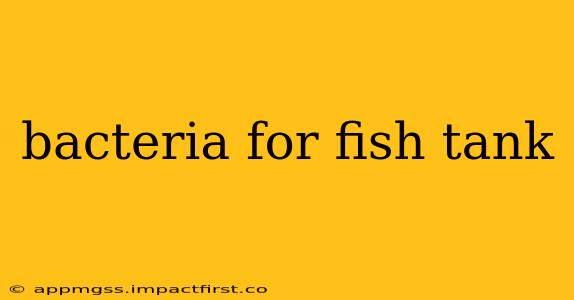Keeping a thriving fish tank requires more than just pretty fish and decorations. A healthy aquatic ecosystem relies heavily on beneficial bacteria, often referred to as nitrifying bacteria. These microscopic organisms are crucial for breaking down harmful waste products, preventing ammonia buildup, and maintaining a safe and healthy environment for your finned friends. This comprehensive guide will delve into the importance of these bacteria, how they work, and how to ensure their presence in your aquarium.
What are Nitrifying Bacteria?
Nitrifying bacteria are a group of specialized microorganisms that play a vital role in the nitrogen cycle, a natural process that converts harmful nitrogenous waste into less toxic forms. Fish produce ammonia (NH3), a highly toxic substance. Without beneficial bacteria, this ammonia would quickly build up, poisoning your fish and making your tank uninhabitable. These amazing bacteria work in two stages:
-
Nitrosomonas: This type of bacteria converts ammonia (NH3) into nitrite (NO2). While less toxic than ammonia, nitrite is still harmful to fish.
-
Nitrobacter: These bacteria take the nitrite (NO2) produced by Nitrosomonas and convert it into nitrate (NO3). Nitrate is the least toxic form of nitrogenous waste and is relatively safe for fish at moderate levels. Nitrate is then removed through regular water changes.
Why are Nitrifying Bacteria Important for Fish Tanks?
The importance of nitrifying bacteria in a fish tank cannot be overstated. Their primary function is to maintain water quality by transforming toxic ammonia and nitrite into less harmful nitrate. Without them, your fish would quickly succumb to ammonia poisoning. A healthy colony of these bacteria is essential for:
-
Preventing ammonia poisoning: Ammonia is deadly to fish, even in small concentrations. Nitrifying bacteria prevent lethal ammonia buildup.
-
Maintaining water quality: By removing toxic compounds, they ensure clean and healthy water for your fish.
-
Creating a stable ecosystem: A balanced ecosystem relies on the effective functioning of the nitrogen cycle, which is entirely dependent on these bacteria.
How to Establish a Colony of Beneficial Bacteria in Your Fish Tank?
Establishing a healthy colony of nitrifying bacteria takes time and patience. It's a crucial process known as the "nitrogen cycle." Here's how to do it:
-
Cycle your tank: Before adding any fish, you must cycle your tank. This involves introducing ammonia (through fish food or an ammonia source) to the tank and monitoring the levels of ammonia, nitrite, and nitrate over several weeks. As the bacteria colonies grow, they will convert the ammonia and nitrite to nitrate, indicating a successful cycle.
-
Avoid overfeeding: Overfeeding introduces excess ammonia into the tank, potentially overwhelming the bacterial colony and leading to a spike in toxic levels.
-
Regular water changes: While nitrate is less harmful than ammonia and nitrite, it still needs to be controlled. Regular partial water changes help remove accumulated nitrate.
-
Avoid using chlorine and chloramine removers: These chemicals can kill beneficial bacteria. Always use a water conditioner to neutralize these substances.
What Happens if My Fish Tank Lacks Beneficial Bacteria?
A fish tank lacking sufficient beneficial bacteria is a recipe for disaster. The consequences can include:
- Ammonia poisoning: This will lead to fish death.
- Fish disease outbreaks: Poor water quality weakens the immune system of fish, making them more susceptible to disease.
- Unpleasant odors: The buildup of ammonia and other waste products will create a foul smell.
- Algae blooms: An imbalance in the nitrogen cycle can lead to excessive algae growth.
How can I tell if my tank is properly cycled?
A properly cycled tank will exhibit zero ammonia and nitrite levels, with a moderate level of nitrate. Regular testing with a reliable test kit is essential to monitor the levels and ensure the health of your aquatic ecosystem.
Are there any products that can help establish beneficial bacteria faster?
Several commercially available products claim to accelerate the cycling process by introducing live bacteria cultures. While these can be helpful, they are not a substitute for proper cycling techniques and regular monitoring.
Can I transfer beneficial bacteria from one tank to another?
Yes, you can transfer some bacteria by adding filter media or gravel from an established tank to a new one. However, this method isn't foolproof and still requires careful monitoring of water parameters. It's important to note that not all bacteria will survive the transfer.
By understanding the crucial role of beneficial bacteria in maintaining a healthy fish tank, you can provide a thriving and safe environment for your aquatic pets. Remember that patience, regular monitoring, and responsible aquarium maintenance are key to success.
